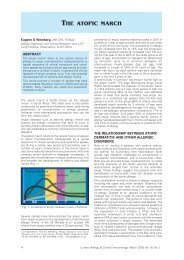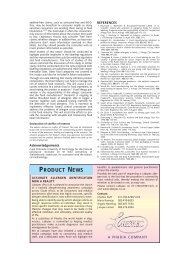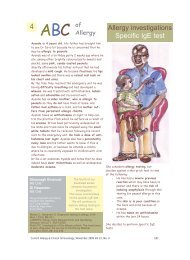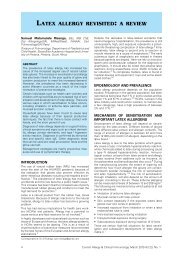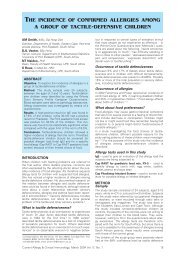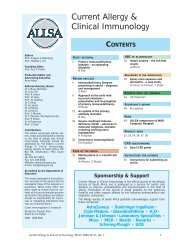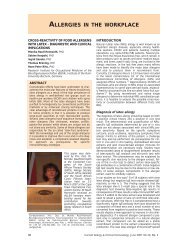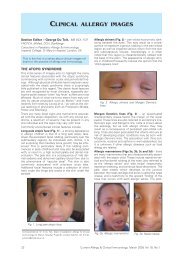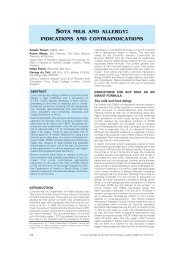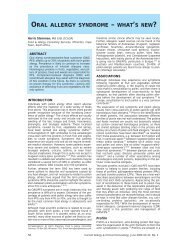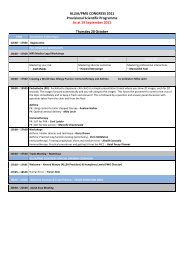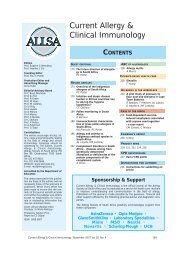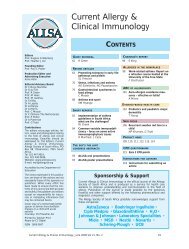You also want an ePaper? Increase the reach of your titles
YUMPU automatically turns print PDFs into web optimized ePapers that Google loves.
lasting up <strong>to</strong> 4 hours. If these are required frequently,<br />
the patient should seek medical help. During an acute<br />
attack, in lieu of a nebuliser, an SAB2, via MDI plus<br />
spacer may be used (20 puffs for adults and 10 puffs<br />
for children – one puff at a time). If there is no improvement<br />
refer <strong>to</strong> doc<strong>to</strong>r for possible oral steroids. Longacting<br />
β 2 -agonists (salmeterol or formoterol), should<br />
only be used in conjunction with inhaled corticosteroids<br />
(ICS), and never administered <strong>to</strong> preschoolers. Sideeffects<br />
include tremor, palpitations, headaches and<br />
facial flushing. In the case of under-2-year-olds and<br />
the elderly, ipratropium bromide (e.g. Ipvent) may be<br />
prescribed. Beneficial effects are noted 30-40 minutes<br />
after administration and side-effects include dry mouth<br />
and constipation.<br />
Explain the actions of controllers<br />
Identify specific device <strong>to</strong> be used and the dose required<br />
(budesonide, fluticasone propionate or beclomethasone).<br />
Explain that if taken regularly, every morning<br />
and every evening, the inflammation in the airways<br />
which causes asthma symp<strong>to</strong>ms will be reduced and<br />
this in turn should reduce the severity and frequency of<br />
acute attacks. Patients should not s<strong>to</strong>p until they next<br />
see their doc<strong>to</strong>r, even though symp<strong>to</strong>ms are not present.<br />
Side-effects are rare but may include hoarseness<br />
or oral thrush. This may be overcome by using a spacer<br />
or regular rinsing of the mouth, after each ICS administration.<br />
Reassure patients that corticosteroids used for<br />
asthma are different from anabolic steroids used by athletes.<br />
The appropriate device should be demonstrated<br />
and checked. Always have a placebo available and<br />
demonstrate the device yourself, then ask patient <strong>to</strong> do<br />
so. Watch closely and discuss any concerns. Correct<br />
technique with inhaler is essential and adherence vital.<br />
Tables I and II and Figure 1 illustrate and outline device<br />
techniques and care.<br />
An emergency action plan should be written down,<br />
taking in<strong>to</strong> account the patient’s lifestyle. Printed action<br />
plans are available at www.asthma.co.za<br />
Discuss a self-management plan. This should include<br />
the nature of asthma and how the patient can recognise<br />
signs and symp<strong>to</strong>ms of worsening asthma. These<br />
include deterioration in peak flow (if meter is used), increase<br />
in diurnal variations, an increase in symp<strong>to</strong>ms<br />
with more frequent use of bronchodila<strong>to</strong>rs, yet declining<br />
efficacy of same. Sleep disturbance and a decrease in<br />
exercise <strong>to</strong>lerance should also be recognised as signs of<br />
impending asthma deterioration. In addition, the patient<br />
should be <strong>to</strong>ld (and the plan written down) what action<br />
<strong>to</strong> take and where <strong>to</strong> go – even in the middle of the<br />
night, when <strong>to</strong> start prednisolone, how much, and how<br />
<strong>to</strong> avoid triggers (including smoking). Asthma symp<strong>to</strong>m<br />
and adherence diary available at www.asthma.co.za<br />
Finally, and most importantly, make a follow-up appointment.<br />
On all subsequent follow-up visits adherence<br />
(how many times did you forget your medication),<br />
inhaler technique evaluation, and an exploration<br />
of possible different health beliefs and/or psychological<br />
issues should be addressed in order <strong>to</strong> achieve optimal<br />
control.<br />
CONCLUSION<br />
A trained enthusiastic allergy and asthma nurse can<br />
work <strong>to</strong>gether with the health team and patients in order<br />
<strong>to</strong> strive for improved control and quality of life for<br />
all patients.<br />
THE FUTURE<br />
It would be a great advantage <strong>to</strong> have an allergy course<br />
where nurses can be trained as allergy nurse practitioners,<br />
who will work in conjunction with allergists and<br />
also function at primary health clinics where specialists<br />
are not always available. They could work in pathology<br />
services where they can conduct basic allergy tests,<br />
e.g. skin-prick tests. These allergy nurse practitioners<br />
would also provide patient education in areas beyond<br />
specialist clinics and assist doc<strong>to</strong>rs <strong>to</strong> refer patients <strong>to</strong><br />
the specialised centres when necessary.<br />
Acknowledgement<br />
We thank the authors of the National Asthma Education Programme<br />
Version 2011 which has been used for this article.<br />
We thank Prof Paul Potter for his invaluable assistance in the preparation<br />
of this article.<br />
Declaration of conflict of interest<br />
The authors declare no conflict of interest.<br />
References<br />
1. Lalloo U, Ainslie G, Wong M, et al. Guidelines for the management<br />
of asthma in adults and adolescents. South African Family Practice<br />
2007; 49 (5): 19-31.<br />
2. Motala C, Green RJ, Manjra AI, et al. Guideline for the management<br />
of chronic asthma in children - 2009 update. S Afr Med J 2009; 99:<br />
897-912.<br />
3. Kling S, Goussard P, Gie RP. Treatment of acute asthma in children.<br />
Current Allergy & Clinical Immunology 2011; 24: 22-26.<br />
4. Green RJ, Motala C, Potter PC, eds. <strong>ALLSA</strong> Handbook of Practical<br />
Allergy, 3rd ed. Cape Town: <strong>ALLSA</strong>, 2010: 17.<br />
Would you like <strong>to</strong> receive future copies of this journal<br />
Please contact our national office <strong>to</strong> be added <strong>to</strong> the mailing list.<br />
If you are interested in becoming a member of the Allergy Society of South Africa (<strong>ALLSA</strong>),<br />
please contact Mrs Ruwayda Adams for more details.<br />
<strong>ALLSA</strong> Office<br />
PO Box 88<br />
Observa<strong>to</strong>ry 7935<br />
Tel 021-447-9019<br />
Fax 021-448-0846<br />
Email mail@allergysa.org<br />
144 Current Allergy & Clinical Immunology, August 2011 Vol 24, No.3



